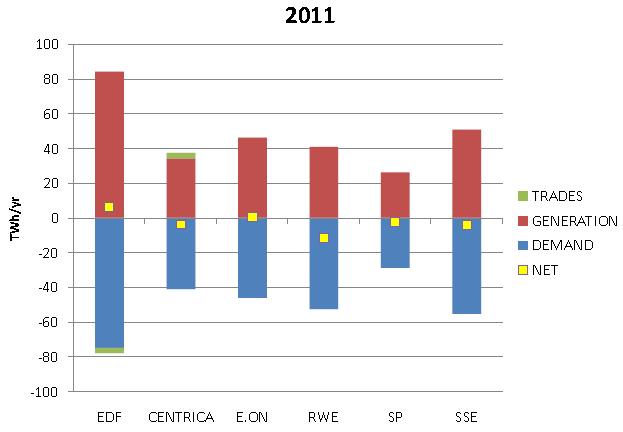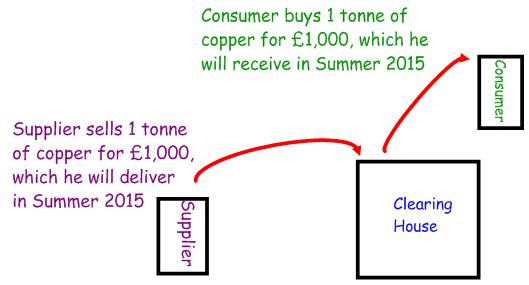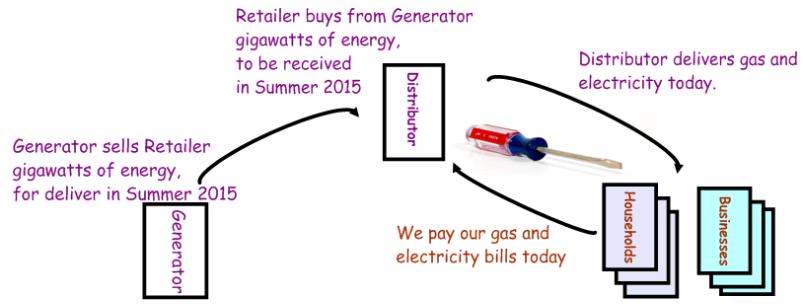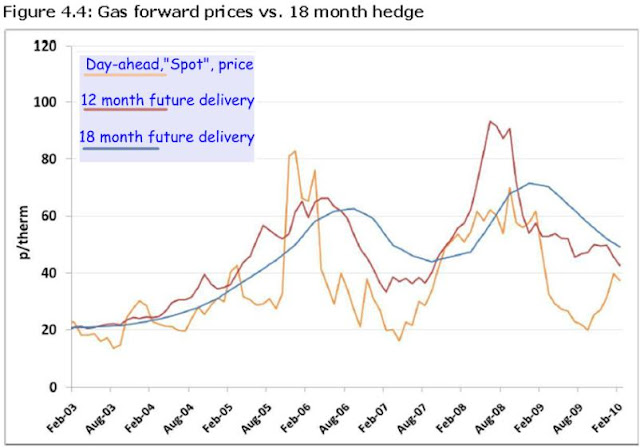Posted by Jake on Sunday, September 25, 2011 with 2 comments | Labels: Article, energy, OFGEM, politicians
With EDF Energy announcing price hikes in September 2011, the last of the Big Six energy companies joined the syncopated pricing goosestep stamping on the wallets of us ripped-off Britons.
All the companies concurred (surely not colluded?) in their main excuse – price hikes are caused by the rise in wholesale energy prices. We are led to believe that those drilling gas producers and electricity generators are inflicting heavy price rises on the poor old retail energy companies, who struggle to keep our bills down but are ultimately forced to kick them up.
“I know it hurts everyone when we put up prices and I wish we didn’t have to.”
“We understand times are difficult, and we’ve done everything we can to absorb these additional costs for as long as possible.”
EDF justified its September 2011 price hike by showing a graph of the wholesale price since November 2010:
But, like the tantalising dancers of the orient, they are careful not to twitch their veil back a further few months, which embarrassingly for them shows the price had just fallen by an even greater amount.
The fact is the retail energy companies, who bill us, buy their wholesale gas and electricity from...you guessed it...themselves. The gouging generators, who snatch the coal and gas from the Earth and generate the wholesale electricity, are the retailers’ own conjoined twins. Each of the ‘big six’ are now able to supply virtually all their own needs. The graph below from OFGEM shows above the zero line how much energy the retail companies' generation twin can generate, and below the zero line how much energy the companies sell to the likes of you and me and the businesses that employ us. All six are more or less in balance – they can supply their own demands. [In the graph, RWE is the owner of nPower, SP is Scottish Power]
Since 2004 the energy industry has simply moved its profits from the retail side of the business to the wholesale generation business. As can be seen from the soaring OFGEM graph below showing the Value Chain Profitability:
Their wholesale arms sell to their retail arms at a high price, allowing their retail arms to blame wholesale prices for them hiking our bills. And allowing them to state with a straight face that they are making tiny margins on their retail business
Npower’s excuse for putting up prices in August was also puzzlingly contradictory. In the same media release they blamed recent events such as the 2011 Arab Spring and the Fukushima reactor meltdown in Japan for pushing wholesale prices up.
"Wholesale energy prices have been impacted by events such as the tsunami and Fukushima in Japan, political changes in the Middle East, nuclear shut down in Germany."
And yet they claim that falls in the wholesale price of energy doesn’t affect bills, because they buy their supplies up to 3 years in advance – in which case recent events should be irrelevant.
"Recent media coverage has reported that wholesale energy prices on the ‘Spot Market’ have fallen - this is correct. However, energy suppliers buy in advance, in some cases up to three years; they do not buy all their energy a day or a month ahead from when they require it. Therefore changes on the short term ‘spot market’ have very little impact. npower has already bought a significant proportion of its needs for customers to cover the coming winter period."
The futures market is a vital part of maintaining price predictability – important to business Britain and domestic Britain. So, when the energy companies blame the cost of energy they bought 3 years ago for putting up prices today, what do they mean?
In a well regulated futures market, such as the market for industrial metals including copper, things work pretty much as they should. Consider a futures trade, in which one tonne of copper is bought to be delivered a couple of years in the future:
The futures contract fixes the price of the copper - a guaranteed price for something that will be delivered in the future. This gives certainty to the Supplier and the Consumer so that they won't be harmed by significant price changes in the months or years until the copper is delivered. The consumer, perhaps a builder putting up a big condominium complex, won't get round to wiring the building until the structure is put up which will take a year. He wants to know what the copper wire will cost him, so he can put a price on the condominiums and start pre-selling them before building is complete.
To avoid the risk of either the supplier or the consumer going out of business in the months or years and not being around to complete the delivery of and full payment for the copper, the contracts are transferred to a central Clearing House. The way this works is:
- Originally, the Supplier was contracted to deliver to the Consumer, and the Consumer was contracted to pay the Supplier.
- Now the Supplier is contracted to deliver to the Clearing House, and the Consumer is contracted to take delivery from the Clearing House.
The Clearing House takes margin payments from Supplier and Consumer, and is strong enough to absorb any defaults. The Clearing House also maintains a balance between all contracts from thousands of counterparties - contracts to deliver and contracts to receive balance out - so it is unlikely to ever have to supply or take delivery of any copper.
The Clearing House takes margin payments from Supplier and Consumer, and is strong enough to absorb any defaults. The Clearing House also maintains a balance between all contracts from thousands of counterparties - contracts to deliver and contracts to receive balance out - so it is unlikely to ever have to supply or take delivery of any copper.
If the price of copper starts falling, say to £900 on the delivery date, this is good for the Supplier, who still gets £1,000.
If the Consumer thinks the price will continue to fall, and so doesn't want the £1,000 copper anymore, believing he can buy later at an even lower price as copper continues to fall, he sells copper at the current price of £900 to another trader (freezing the Consumer's losses at £100). The trader is confident he can unload this at a profit later.
This new contract is also transferred to the Clearing House.
The Consumer now has two contracts with the Clearing House
1) To buy 1 tonne of copper in Summer 2015 at £1,000
2) To sell 1 tonne of copper in Summer 2015 at £900
These two contracts cancel each other out. The Consumer is off the hook, taking a £100 loss but now able to benefit from further falls in the price of copper.
The "spot price", also called the "day-ahead" price, is the true reflection of supply and demand today. The "futures" price is a trader's guess of what the supply and demand will be in the future... or an energy company executive's guess of what OFGEM will let him get away with!
So, what is the impact of all this energy-trading? According to an OFGEM report, since the energy companies switched their profits from their retail business to their generation business in 2005, the energy retailers are typically paying the energy wholesalers twice the true current supply&demand "spot", or "day-ahead", price.
Of course, they are paying this inflated price to themselves. So they're all right. But what about the rest of us?


























Our blog on the regulators failure to ensure genuine competition - though OFGEM may finally have started to grasp the problem:
ReplyDeletehttp://www.uniqueoxford.co.uk/2011/10/the-illusion-of-choice/
If you've had an adjustment or estimate bill I would urge you to check up on it.
ReplyDeleteWe were being chased for an outstanding bill, a year after I paid it I needed to ask for details on the account (DPA request).
The DPA request was never answered but they wrote saying they had done some routine checks and I had been overcharged £250!